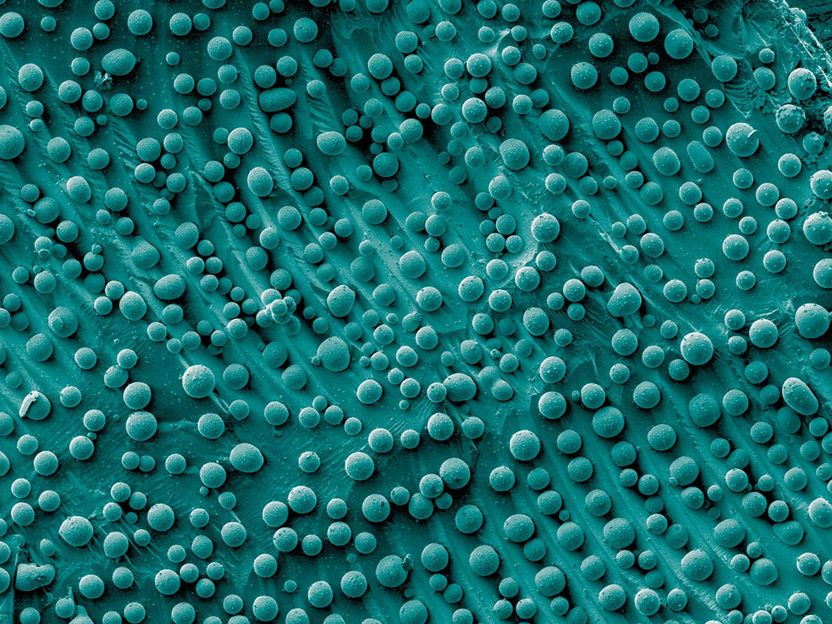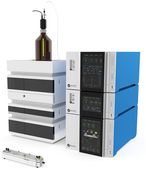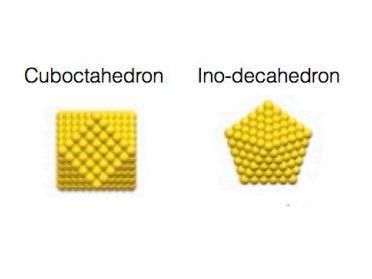Connecting the (Nano)dots
Big-picture thinking can advance nanoparticle manufacturing
Nanoparticle manufacturing, the production of material units less than 100 nanometers in size (100,000 times smaller than a marble), is proving the adage that “good things come in small packages.” Today’s engineered nanoparticles are integral components of everything from the quantum dot nanocrystals coloring the brilliant displays of state-of-the-art televisions to the miniscule bits of silver helping bandages protect against infection. However, commercial ventures seeking to profit from these tiny building blocks face quality control issues that, if unaddressed, can reduce efficiency, increase production costs and limit commercial impact of the products that incorporate them.

Electron micrograph showing gallium arsenide nanoparticles of varying shapes and sizes. Such heterogeneity can increase costs and limit profits when making nanoparticles into products. A new NIST study recommends that researchers, manufacturers and administrators work together to solve this, and other common problems, in nanoparticle manufacturing.
A. Demotiere, E. Shevchenko/Argonne National Laboratory
To help overcome these obstacles, the National Institute of Standards and Technology (NIST) and the nonprofit World Technology Evaluation Center (WTEC) advocate that nanoparticle researchers, manufacturers and administrators “connect the dots” by considering their shared challenges broadly and tackling them collectively rather than individually. This includes transferring knowledge across disciplines, coordinating actions between organizations and sharing resources to facilitate solutions.
“We looked at the big picture of nanoparticle manufacturing to identify problems that are common for different materials, processes and applications,” said NIST physical scientist Samuel Stavis, lead author of the paper. “Solving these problems could advance the entire enterprise.”
The new paper provides a framework to better understand these issues. It is the culmination of a study initiated by a workshop organized by NIST that focused on the fundamental challenge of reducing or mitigating heterogeneity, the inadvertent variations in nanoparticle size, shape and other characteristics that occur during their manufacture.
“Heterogeneity can have significant consequences in nanoparticle manufacturing,” said NIST chemical engineer and co-author Jeffrey Fagan.
In their paper, the authors noted that the most profitable innovations in nanoparticle manufacturing minimize heterogeneity during the early stages of the operation, reducing the need for subsequent processing. This decreases waste, simplifies characterization and improves the integration of nanoparticles into products, all of which save money.
The authors illustrated the point by comparing the production of gold nanoparticles and carbon nanotubes. For gold, they stated, the initial synthesis costs can be high, but the similarity of the nanoparticles produced requires less purification and characterization. Therefore, they can be made into a variety of products, such as sensors, at relatively low costs.
In contrast, the more heterogeneous carbon nanotubes are less expensive to synthesize but require more processing to yield those with desired properties. The added costs during manufacturing currently make nanotubes only practical for high-value applications such as digital logic devices.
“Although these nanoparticles and their end products are very different, the stakeholders in their manufacture can learn much from each other’s best practices,” said NIST materials scientist and co-author J. Alexander Liddle. “By sharing knowledge, they might be able to improve both seemingly disparate operations.”
Finding ways like this to connect the dots, the authors said, is critically important for new ventures seeking to transfer nanoparticle technologies from laboratory to market.
“Nanoparticle manufacturing can become so costly that funding expires before the end product can be commercialized,” said WTEC nanotechnology consultant and co-author Michael Stopa. “In our paper, we outlined several opportunities for improving the odds that new ventures will survive their journeys through this technology transfer ‘valley of death.’”
Finally, the authors considered how manufacturing challenges and innovations are affecting the ever-growing number of applications for nanoparticles, including those in the areas of electronics, energy, health care and materials.
Original publication
Other news from the department science
These products might interest you

NANOPHOX CS by Sympatec
Particle size analysis in the nano range: Analyzing high concentrations with ease
Reliable results without time-consuming sample preparation

Eclipse by Wyatt Technology
FFF-MALS system for separation and characterization of macromolecules and nanoparticles
The latest and most innovative FFF system designed for highest usability, robustness and data quality

DynaPro Plate Reader III by Wyatt Technology
Screening of biopharmaceuticals and proteins with high-throughput dynamic light scattering (DLS)
Efficiently characterize your sample quality and stability from lead discovery to quality control

Get the chemical industry in your inbox
By submitting this form you agree that LUMITOS AG will send you the newsletter(s) selected above by email. Your data will not be passed on to third parties. Your data will be stored and processed in accordance with our data protection regulations. LUMITOS may contact you by email for the purpose of advertising or market and opinion surveys. You can revoke your consent at any time without giving reasons to LUMITOS AG, Ernst-Augustin-Str. 2, 12489 Berlin, Germany or by e-mail at revoke@lumitos.com with effect for the future. In addition, each email contains a link to unsubscribe from the corresponding newsletter.
Most read news
More news from our other portals
See the theme worlds for related content
Topic world Synthesis
Chemical synthesis is at the heart of modern chemistry and enables the targeted production of molecules with specific properties. By combining starting materials in defined reaction conditions, chemists can create a wide range of compounds, from simple molecules to complex active ingredients.

Topic world Synthesis
Chemical synthesis is at the heart of modern chemistry and enables the targeted production of molecules with specific properties. By combining starting materials in defined reaction conditions, chemists can create a wide range of compounds, from simple molecules to complex active ingredients.
Topic world Sensor technology
Sensor technology has revolutionized the chemical industry by providing accurate, timely and reliable data across a wide range of processes. From monitoring critical parameters in production lines to early detection of potential malfunctions or hazards, sensors are the silent sentinels that ensure quality, efficiency and safety.

Topic world Sensor technology
Sensor technology has revolutionized the chemical industry by providing accurate, timely and reliable data across a wide range of processes. From monitoring critical parameters in production lines to early detection of potential malfunctions or hazards, sensors are the silent sentinels that ensure quality, efficiency and safety.
Last viewed contents

CG Drives & Automation - Wernigerode, Germany
scienceindustries - Zürich, Switzerland
Bohui Innovation Biotechnology will acquire the Interchim group

Battery analytics - Characterization of raw materials & semi-finished products for battery industry
European Aliphatic Isocyanate Producers Association (ALIPA) - Brüssel, Belgium





























































